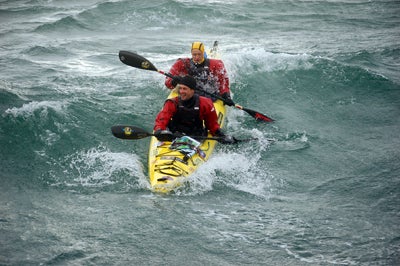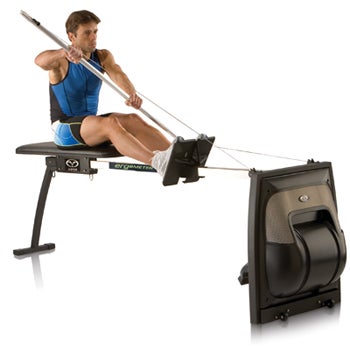
By
This winter, I have kicked my athletic training into high gear. In February, I am traveling to Chile to captain a team in the Wenger Patagonian Expedition Race, anultra-endurance event through Tierra del Fuego. The multi-day race will include long treks, mountain-bike segments, climbing, and sea kayaking in icy ocean waters at the tip of the South American continent. It's a once-in-a-lifetime event. I want to be prepared.
To get serious about the kayaking sections in the race, for the past three months I have been sitting on a machine in my basement “paddling” for an hour at a stretch. The Kayak Ergometer, an esoteric exercise machine made by Vasa Inc. of Essex Junction, Vermont, has a paddle-like shaft to grip, a contoured seat, foot braces, and a flywheel drive that gives resistance with each pulled stroke.
The machine mimics the kayaking experience better than anything I have tried. My strengthened abs, shoulders and arms are testimony to the Ergometer's efficiency in whipping a body into paddling shape.
The Kayak Ergometer, priced a hefty $1,999 at, debuted in 2007 with foot braces and a bench seat. New for this winter, Vasa adds a kayak-seat option. Called the K1 Swivel Seat, the new feature better matches the feel of being in a boat. I tested an early prototype. The final product will be on the market February 1, a few days before I depart for Patagonia.

Using the Vasa unit now for a few months, I have cometo like the sound of the machine: Pull a stroke with the paddle shaft and youforce air through the flywheel fan. The quiet noise and moving air conjurewaves and natural movement on a lake.
The resistance is even throughout the whole stroke, making for an accurate substitute to pulling a paddle blade through water. There are varying levels of resistance to set, letting you simulate paddling down-river or upstream against a current.
A small digital monitor displays your time, distance, pace, and power output in watts. It can measure right and left arm force individually, letting you adjust technique if one side overpowers.
Though I have only used the Vasa machine in kayak mode, with the bench and different grips it can be configured as a training tool for swimming, XC ski poling, canoeing, and other types of paddling. The K1 Swivel Seat, as the name implies, will swivel when you stroke. This is for K1 kayak race training. For sea-kayak training, the swivel can be locked with the seat set in a stationary position.
Overall, my criticisms are minimal. The price is high, and this is a niche product. Not everyone will want to jump on a Vasa machine night after night. The motion, like with any exercise machine, is repetitive, though I did not find it to be tedious.
The foot brace works fine. But I would prefer it to be wider to mimic how my feet fit inside a kayak hull. While training, I place my feet as wide as I can on the Vasa's brace.
In three months, so far, the Vasa Kayak Ergometer has made me a significantly stronger paddler. I feel fit and ready for my big race in February, where we'll face hours of paddling in some of the most remote waters in the world. Patagonia here I come!
–Stephen Regenold writes about outdoors gear at.